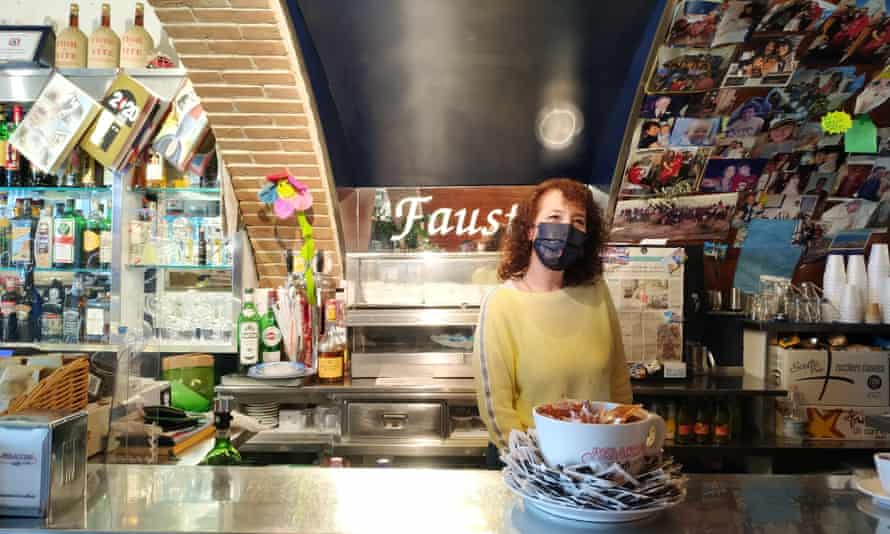If anyone is strategically placed to take note of the people setting foot on the tiny Italian island of Giglio it’s Rosalba Pellegrini. Her bar and pastry shop, Fausto, faces the port, where ferries arrive from Porto Santo Stefano, a town on the Tuscan peninsula of Monte Argentario. A smattering of people, mainly hikers and cyclists, descended from the midday boat on Monday.
“We’ve seen a few new faces coming over the last couple of weekends, but otherwise it is very, very quiet,” she said.
That could be about to change now that Italy has dropped Covid-19 quarantine measures for tourists arriving from EU and Schengen area countries, as well as the UK and Israel. The quarantine has also been removed for visitors travelling from the US, Canada, Japan and the United Arab Emirates onboard Covid-tested flights. All tourists will need to provide evidence of having been fully vaccinated with an EU-approved Covid-19 vaccine, of having recovered from the virus or tested negative 48 hours prior to travelling.

Like other small Italian islands, Giglio will next week vaccinate its entire population of about 1,400, as well as seasonal workers, as it readies for the summer season.
“We did surprisingly well last summer even though the season started late,” added Pellegrini. “But it’s been a long and tough winter. We practically all live off tourism, so it’s fundamental for the island’s survival.”
Giglio boasts several pristine bays with crystal clear water and is a paradise for walkers, but it is mostly known beyond Italy for the tragedy of the Costa Concordia, the cruise ship which partially sank just metres away from the island’s shore in January 2012, killing 32 people. The huge, rusting hulk of the vessel loomed over Giglio’s port – attracting plenty of day-trippers who called by for a quick photograph – before being removed in July 2014.
Sergio Ortelli, the mayor of Giglio, has since worked hard to promote the island to foreign tourists.
“Giglio was passed by during the Costa Concordia period as many people associated the island with terror,” said Ortelli. “So we did a big tourism campaign all over the world and organised cultural events to try and get people back. Giglio is not a big island but it is welcoming, and we’re ready to host people.”
Ortelli expects all islanders to be vaccinated by the end of next week. “In June last year, I became the first mayor in Italy to make it obligatory for people to wear face masks outside,” he said. “Now that we have the vaccine, I hope to become the first mayor to remove the requirement for face masks outside.”
There is much enthusiasm on the island for the jab. “We’re all very willing to do it,” said Federica Andolti, who works at Bumbabar, a bar and restaurant in Giglio Castello, a medieval village perched on the top of the island. “Up until recently, only Tuscans could visit, or those who had a second home. We’re hoping for a good season, and one without any Covid.”
Italy introduced its travel “green pass” before the launch in June of the EU’s equivalent to try to salvage an industry which, before the pandemic, accounted for 14% of GDP.
“Few countries are intertwined with tourism as Italy,” Mario Draghi, Italy’s prime minister, said this month.
Alongside the plan, the country’s vaccination programme has accelerated in recent weeks. Over 28 million people had received one dose as of Tuesday, while almost 9 million are fully vaccinated. Italy registered 4,452 new infections on Tuesday and 201 more deaths as Draghi’s government further eased restrictions, including shortening the nightly curfew and potentially scrapping it completely on 21 June. All of Italy’s 20 regions, apart from the Aosta valley, are now in the low-risk “yellow zone”, allowing people to travel freely between each.
The research institute Demoskopika painted an optimistic picture on Monday, estimating that at least 39 million foreign and domestic tourists would take trips in Italy this summer, up 12% on last year.
“The vaccine plan and [travel] green pass are undoubtedly an incentive for the process of tourism recovery,” Raffaele Rio, the president of Demoskopia, told Ansa news agency.
Across the sea from Giglio on Monte Argentario, people like Stefania Marconi, who manages Torre di Cala Piccola, a hotel overlooking a small bay, are counting on the recovery.
The hotel reopened on Friday. “We are starting to get bookings, but, like last year, we had to invest a lot in preparing and a lot of work goes into making sure everything is safe,” said Marconi. “But we are very enthusiastic about getting going again and are ready to welcome people back.”




